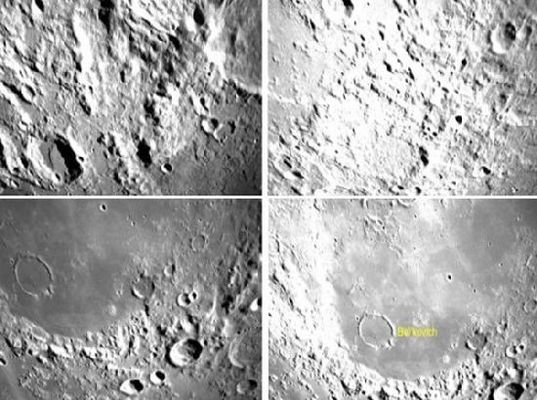Chandrayaan-3’s lander establishes communication, sends images of Moon’s far side area
BENGALURU: ISRO on Monday said the Chandrayaan-3 mission’s lander module has established communication with the Chandrayaan-2 orbiter, and released images of the lunar far side area captured by the Lander Hazard Detection and Avoidance Camera (LHDAC).

The lander, along with a rover accommodated inside it, of India’s third lunar exploration mission is expected to touch down on the surface of the Moon around 6.04 pm on Wednesday, according to the national space agency.
” Welcome, buddy!’ Ch-2 orbiter formally welcomed Ch-3 LM. Two-way communication between the two is established. MOX has now more routes to reach the LM,” ISRO said in a post on ‘X’.
As per specifications, in addition to Chandrayaan-2 orbiter, the lander of Chandrayaan-3 has the capability to communicate with the Indian Deep Space Network (IDSN), a network of large antennas and communication facilities operated by ISRO to support the interplanetary spacecraft missions of India, at Byalalu in Ramanagara district, and the 26 kg rover.
The MOX (Mission Operations Complex) is located at ISRO Telemetry, Tracking and Command Network (ISTRAC) here.
ISRO also said, in an update, that the live telecast of the landing event will begin at 5.20 pm on Wednesday.
The Chandrayaan-2 spacecraft comprising orbiter, lander and rover was launched in 2019. The lander with rover in its belly crashed into the Moon’s surface, failing in its mission on soft-landing.
ISRO said in 2019 that due to the precise launch and orbital manoeuvres, the mission life of the orbiter has increased to seven years.
The LHDAC that assists in locating a safe landing area — without boulders or deep trenches — during the descent is developed by Ahmedabad-based Space Applications Centre (SAC), a major research and development centre of ISRO.
According to the space agency, several advanced technologies are present in the lander such as LHDAC to achieve the mission objectives of Chandrayaan-3.
Chandrayaan-3, launched on July 14, is a follow-on mission to Chandrayaan-2 to demonstrate end-to-end capability in safe landing and roving on the lunar surface.
The mission life of the lander and rover is one lunar day or 14 earth days.
Referring to the expected touchdown, former ISRO chairman G Madhavan Nair kept his fingers crossed and said it’s a very complex manoeuvre and one has to be cautious as all systems have to work in unison for its success.
Nair, who headed the space agency when Chandrayaan-1 mission was launched in 2008, said a successful landing would herald a big beginning for ISRO’s next phase of planetary exploration.
“It’s a very complex manoeuvre. We narrowly missed it (soft-landing on the Moon in Chandrayaan-2 mission) in the last two kilometres (above the lunar surface),” he told PTI on Monday.
“So, there are a host of things that have to work in unison…thrusters, sensors, altimeters, computer software and all those things. Any glitch happening anywhere…we can be in trouble,” Nair said.
“We have to be really cautious and watch. Of course, I understand that ISRO has done enough simulations and also redundancies have been built in so that chances of such failure are remote. Still, we have to keep our fingers crossed.”
Nair said: “Data we may collect from the (lunar) surface will be useful in identifying some minerals…rare minerals, if at all, helium-3 and so on. Also, try to have some investigations as to what type of setup we can have near the lunar south pole either for exploration or human presence. It (successful soft-landing) is going to be a big beginning for ISRO’s next phase of planetary exploration”.
Nair and another former ISRO chairman K Sivan said the failure of Russia’s Luna-25 moon mission would have no impact on Chandrayaan-3.
Russia’s Luna-25 spacecraft crashed into the Moon after it spun into an uncontrolled orbit, the country’s Roscosmos space agency said on August 20.
“It does not have any impact,” Sivan, who was heading ISRO when Chandrayaan-2 mission was launched in 2019, told PTI when asked if ISRO would be under additional pressure ahead of the soft-landing following the Russian setback.
“It (Chandrayaan-3 mission) is going on as per plan. It (soft-landing) will be done accordingly,” he said. “We are hoping that this time (unlike Chandrayaan-2) it (touchdown) will be successful”.
Nair dismissed suggestions in some quarters that India and Russia were engaged in a race to the Moon and termed crash-landing of Luna-25 as unfortunate.
“I know the (lander) module. It was ready way back in 2008. When I visited the lab (in Russia), they showed me the module. They didn’t have the resources to fly (then), so, it had been kept in a cold storage for a long time. Now only they had resources (to launch),” he told PTI.
Ruling out any impact on Chandrayaan-3 mission launched on July 14, Nair said India’s venture is totally independent and “we are not dependent on them (Russia)”. Right now, India’s space cooperation with Russia is limited to training of Indian astronauts for the Gaganyaan human space flight mission.
“So, had it (Luna-25) landed, our data and their (Russian) data (collected based on experiments on the Lunar surface) would have been complementary,” he said. (PTI)
